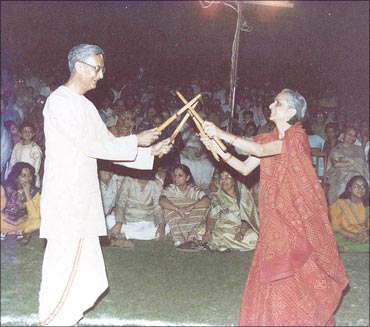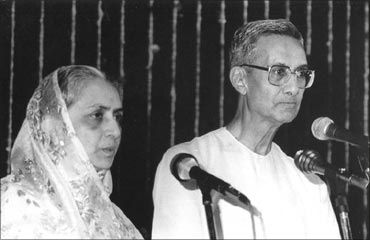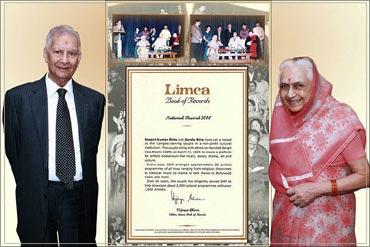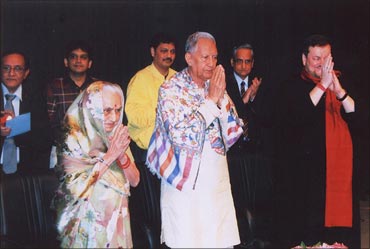Sushma Ramachandran
The Birlas could be described as the Rockefellers of India.
Just as the name Rockefeller is scattered all over America on various institutions, similarly the name Birla is spread far and wide over colleges, schools and temples in all parts of India.
The canny Marwari clan that originated from a small town called Pilani in Rajasthan became the tallest industrial house in this country in the 20th century rivalled just by the Tatas in post-Independence India.
It was only in the 60s that the names of other industrial family groups could be taken in the same breath as those of the Birlas and the Tatas.
The Birlas became well-known when patriarch G.D. Birla used his wealth to support the Independence movement and became not just a friend to, but a follower of, Mahatma Gandhi.
Birla House in Delhi is indelibly inked into the history of Independent India as Gandhi was assassinated on its lawns soon after a prayer meeting. The Birla residence had become a hub prior to Independence for those fighting for freedom and especially the Congress Party.
It was, however, Sardar Patel to whom G D Birla was close and the rise of Jawaharlal Nehru as India's first prime minister with socialist leanings that came as a dampener to the industry giant.
. . .
The story of the first couple of the Birla empire
Image: B K Birla and wife Sarala.Photographs: Courtesy, Sangit Kala Mandir
Rashme Sehgal's biography of G D's youngest son B K Birla and wife Sarala -- Life Has No Full Stops -- becomes a history of the Birla family right from its roots in Pilani to its present heights.
The family tree printed on the inside front cover is itself fascinating as it depicts the growth of this industrial house over several generations.
BK's role in expanding GD Birla's empire is outlined in the biography as well as that of son Aditya Birla who died before achieving his full potential, leaving son Kumaramangalam to preside over the multinational corporations created during his lifetime.
Apart from the chronicles of the business house, the book records the personal life and family culture not just of Basant Kumar and Sarala but also the entire Birla family.
One of the most fascinating chapters is that of the first meeting between B K and Sarala in the first step towards their arranged marriage.
What is startling is that though the marriage was being duly arranged by elders, Sarala was not prepared to marry anyone she had never met.
So she travelled from Pune by train to Mumbai and walked into the Birla residence all by herself without any family members to meet the entire Birla clan.
. . .
The story of the first couple of the Birla empire
Photographs: Courtesy, Sangit Kala Mandir
Probably far more self assured than even today's young women of the Birla family, she had no qualms about going for the meeting alone, having a dekko at Basant Kumar Birla and returning in the same way.
Even after this, she was not satisfied as they were not able to speak to each other during this meeting. This led to a second meeting at her family residence where the nervous Basant was able to charm both Sarala and her family.
Quite revolutionary for a Marwari family in the early 1920s, this English speaking liberal young woman later became a favourite of the entire family.
The first photo in the book shows Sarala wearing trousers, standing with her head resting on her husband's shoulder, just like any newly wed of the 21st century.
With a mother like Sarala, no wonder that son Aditya charted a new path for Indian industry by creating an empire beyond the country's shores with a host of companies in southeast Asia.
This at a time when India's industrialists were incessantly focussed just on surviving within the country.
Basant Kumar is depicted as a modest man, far removed from the flamboyant present day tycoons. His only luxury seems to have been travel. But this was not just abroad.
. . .
The story of the first couple of the Birla empire
Photographs: Courtesy, Sangit Kala Mandir
He has already trekked an amazing 17 times to Kedarnath with wife Sarala, apart from many other pilgrimages on a regular basis. Like Sarala, he seems to have been the modern liberal face of his family highlighted by his focus on education.
Even when directed to get married by his father, he insisted that an English speaking bride, a condition that forced his family to look far and wide for an educated girl.
Personal and public life is inextricably linked in this story. BK's early life was marred by the tragic death of his mother while he was quite young.
Sent off to live in Pilani with their grandmother for two years, BK and elder brother KK had to contend with a life of frugality and discipline with the matriarch rationing out fruits, and even pencils and paper to the children.
Finally GD realised his sons' unhappiness and brought them back to Calcutta. At the age of 14, BK was brought into the family business and by 18 was even running his own companies while simultaneously studying in college.
But the abrupt end of his schooling was disappointing for him. He tried to make up for his own lack of education by ensuring that son Aditya went abroad to study business management to prepare him for taking over the reins.
Even so, the first Birla scion to study in foreign universities was warned "no drinking, no smoking and no dancing".
. . .
The story of the first couple of the Birla empire
Photographs: Courtesy, Sangit Kala Mandir
The lack of formal higher education was clearly not a deterrent to BK's rise in business as his accounting skills became legendary. Sick companies were handed over to him to be turned round and BK fulfilled the faith reposed in him by bringing these units back to profitability.
The book also details GD Birla's strict rules of ensuring his sons learnt the traditional Marwari accounting skills and putting them through the wringer of learning from the bottom rung of the company. A system very unlike the pampering nowadays showered on scions of large industrial houses.
One of the themes in Sehgal's biography is the way in which the Birla name came to be synonymous with education. A school was first launched by BK and Sarala when they could not find a good one for their children.
The Mahadevi Birla Shishu Vihar - named after his mother - was the first but over the years Birla schools have mushroomed all over the country and became a byword for good quality education.
The famous BITS Pilani was also founded by Basant Kumar and Sarala Birla. Corporate social responsibility is a term coined only now but the concept was well known to the family which has been assiduous in their role in spreading educational facilities far and wide.
Sehgal's book may be a biography commissioned by BK's children but speaks quite frankly of difficult family issues like the fissures which arose over inheritance issues after the death of patriarch GD Birla.
She quotes family members expressing their unhappiness over the most profitable companies being given to BK and his son, Aditya, who was GD's favourite grandson.
. . .
The story of the first couple of the Birla empire
Photographs: Courtesy, Sangit Kala Mandir
It is also candid about the anguish of one of BK's daughters not being able to conceive a male heir in true Marwari tradition.
This volume is a mine of information about the Birla family and its climb to greatness. The only complaint one can have with it that it leaves you wanting to know much more.
For instance, why is BK more successful than others in his family. Is it just due to the larger inheritance from his father or his greater business acumen?
As for his son Aditya Birla's success in building a multinational empire in Southeast Asia, it is widely recognised that he was a visionary ahead of his time.
Another book is needed just to outline the business model of the Birla group in general and BK Birla in particular.
For the time being, however, Sehgal's book has to be required reading for anyone wanting to know not just about BK and Sarala Birla but the saga of the entire Birla family.
Basant Kumar and Sarala Birla: Life has no Full Stops
by Rashme Sehgal
Foreword by Amitabh Bachchan
Price: Rs 495
Publisher: Amaryllis







article